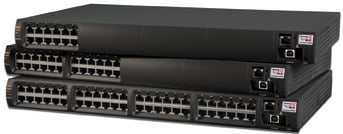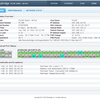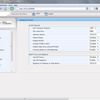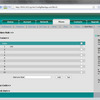Mike McCormack, Chair of the IEEE P802.3at Task Force said, "IEEE 802.3at uses the Link Layer Discover Protocol (LLPD) from IEEE Std 802.1AB, which allows dynamic power allocation and negotiation down to 1/10th of a Watt, and associated technology including Type, Length, Values (TLVs) from IEEE 802.3bc, which was also recently approved. This will allow equipment manufactures to manage their power supply costs and efficiencies at levels not possible with previous standards, and to cut their costs in the process."
I contacted Daniel Feldman, Director of Marketing, Telecom, Microsemi and he responded to Mike's quote by saying, "This is a mis-interpretation of what can be actually done. All LLDP allows is for more devices to be powered with a given power supply, it does not increase the power supply efficiency in any way."
Mike McCormack also stated, "In addition, we have increased available power up to 25W. This will allow Power over Ethernet (PoE) to address applications such as high power Wireless APs, gimbal mounted cameras, and even some netbooks, as well as newer emerging applications."
The new standard is fully compatible with IEEE Std 802.3. "The improvements made in IEEE 802.3at are all fully compatible with any device built to the 802.3-2005 standard," said McCormack.
Soon we should start seeing low-power and high-power IEEE802.3at-2009-compliant VoIP phones, WLAN access points, network cameras, WiMAX subscriber stations and more.
 One firm, Microsemi claims that their PD-9000 Midspan family offers the industry's only solutions to combine IEEE802.3at-2009 compliance, mutual midspan-to-midspan backup capabilities, uninterruptible power supply (UPS) communications, and pre-programmed powered device shutdown, all with simple network management protocol version 3 (SNMPv3)--a secured management that can run on Internet Protocol version 6 (IPv6). In addition, the PD-9000G family provides a safe and cost-effective PoE solution for Ethernet end terminals. More devices can be powered via the network, thus eliminating the need to use a power supply and install costly power outlets close to the end device.
One firm, Microsemi claims that their PD-9000 Midspan family offers the industry's only solutions to combine IEEE802.3at-2009 compliance, mutual midspan-to-midspan backup capabilities, uninterruptible power supply (UPS) communications, and pre-programmed powered device shutdown, all with simple network management protocol version 3 (SNMPv3)--a secured management that can run on Internet Protocol version 6 (IPv6). In addition, the PD-9000G family provides a safe and cost-effective PoE solution for Ethernet end terminals. More devices can be powered via the network, thus eliminating the need to use a power supply and install costly power outlets close to the end device. The PD-9000 family is available in 1-, 6-, 12- and 24- port versions in a 1U format, and a virtual 48-port 2U midspan. Microsemi also offers a 60W midspan family capable of powering network cameras and other devices at up to 51W, without infringing on the new IEEE802.3at-2009 standard.
Interesting that Microsemi is able double the standard 802.3at-2009 maximum of 25W and go up to 51W without breaking the standard. I asked Daniel about this and he responded, "This is possible because the IEEE802.3at-2009 standard changed the definition of a Powered Device, compared to the text existing in IEEE802.3-2005's Clause 33. The new standard considers the PD the power interface, and not the whole device being powerd. This means that one can have two power interfaces, each taking 25.5W inside the same box. And nothing precludes these to be connected one over the 2-pairs using lines 1,2,36 and the other using the 2-pairs that use lines 4,5,7,8. "
And who is creating devices that suck 51W of power if Microsemi is the only midspan that supports 51W over Ethernet cables? Daniel responded, "One good example that can be directly powered is the Axis Q6032E. The beauty of the Microsemi business model is that we don't create only Midspans, we also create PoE splitters. In this specific case, we created a 51W capable splitter that delivers 12 or 24 volts, and we are working on a version that delivers 18V. So ANY application that takes these input voltages and uses 12, 18 or 24 volts could be powered over Ethernet today. We have customers in the Access Control market very excited about our 60W solution."
Ok, so 51W can be quite useful, but at what point does sending that kind of wattage over cables start to cause heating and wire melting issues? Well, last year I interviewed Amit Gattani, Director of Marketing for Akros Silicon and asked him, "There's no issues with the wires melting with this increased wattage in the wires, is there? Especially when these wires run up in the ceilings where it could post a fire hazard?"
Amit Gattani laughed and replied, "That's a very good question. At the standard level we spent a lot of time on this issue. Copper wire has a fairly high capability to carry current. However, heating of the cable, especially when these cables run in the attics and you're pulling 50 cables together in a bundle, heating of the cable can become an issue. One, 13W solutions you can use Cat 5 cable. For 30W it is Cat 5e and above and the reason is that Cat 5e and above have lower resistance drops so the heating issue is less." He added, "The 30W power limitation is actually put in place for a high degree of safety margin from the cable bundle heating up."
I asked Daniel this same question and he responded, "No issue whatsoever. The TIA and ISO/IEC data used to determine that maximum current of 600mA in IEEE802.3at (which is what heats the cable) used a model that assumed all 4-pairs are used, not only 2-pairs. This is because there is no gurantee that split cables are not going to be used in deployments. "
Good to know! Don't need the IT guy burning down the building just for PoE!














